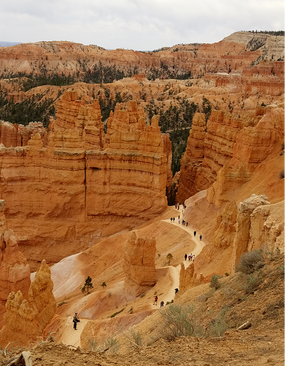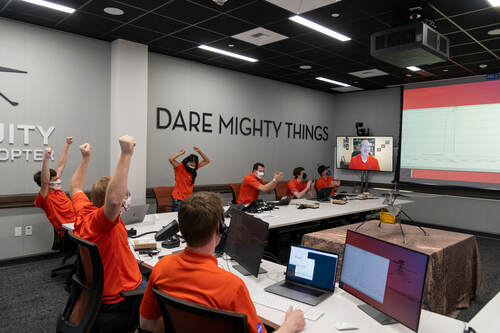 And speaking of life, a sparkling river—the Colorado—runs through it all. That stretch of jade did a lot of the work – eroding the mighty cliffs, shaping, and elevating them over time. The snake-like river a full mile below contrasts with the canyon walls but keeps our focus on the rocks—which are becoming more awe-inspiring and breath-taking as they age. They testify to the wonder of aging.Even as they evoke wonder, can these rocks be considered symbols of hope and joy? Without question, they lift the spirit and humble the intellect. The Grand Canyon, one of the seven natural wonders of the world, does not compete with any other rock formation on earth. But her cousin formations in Utah’s Bryce and Zion national parks have an eerily similar heart-lifting effect. Bryce wows with its “hoodoos,” miles of playful orange-red spires shooting from the earth in magical sculptures. Squint to see a Silent City, Thor’s Hammer, the Chinese Wall or Queen Victoria. Further south, sister canyon Zion overwhelms with Olympian color and height. Here the visitor walks through sunken canyon trails with two-thousand-foot red rock cliffs soaring on either side. We gaze up to The Court of the Patriarchs, Angel’s Landing, and Temple of Sinawava (a Paiute wolf god). The Virgin River gurgles, Archangel Falls hush, and at sunset from Canyon Overlook, silence preserves splendor. Oh joy. A bubble of hope.  Credit: NASA/JPL-Caltech www.mars.nasa.gov/mars2020/ Credit: NASA/JPL-Caltech www.mars.nasa.gov/mars2020/ But you’re right -- they're just rocks. And it is always more compelling to tell stories about real people. So, let’s close with a tribute to some real people who really get rocks, and inspire wonder, hope and joy. Here is a photo of Cal Tech’s Jet Propulsion Laboratory and an intrepid Mars explorer team last month. These happy NASA folks are celebrating the successful launch of “Ingenuity,” a four-pound helicopter that became the first aircraft in earth’s history to fly on another planet. They have reason to rejoice in this "Wright Brothers" moment because they designed it. Launched from the Mars Perseverance Rover, the rotors bit into the thin atmosphere, lifted, and sent back splendid images. Of red rock. And of massive craters, winding channels, dips and swells. The 2020 NASA Mars team is building on the tradition of linking new wonders to all world civilizations. The Rover Perseverance set down in the enormous “Jezero Crater,” which scientists speculate was once a lake fed by a winding channel of a river. Jezero is a Slavic word meaning “lake” and NASA chose the name specifically to salute the small Bosnian village of Jezero with geography (lake and river delta) eerily similar to the Martian landing site. After its war-torn recent history, the thirteen hundred citizens of Jezero now have a lot to cheer about. “It is the most fascinating and unique experience for us,” a student at the village school said. “The mighty Perseverance rover landing in a crater on the red planet that owes its name to our town. Wow!” (On the day of the landing the town of Jezero sponsored a volley ball game between “Earth” and “Mars.” Mars won.) The section of the crater where Perseverance landed is named “Tséyi,” a Navajo term for the heart of their homeland (Arizona’s Canyon de Chelly). A series of other Martian landmarks will receive Navajo names too; for example, a distinctive rock the team is drilling into is named “Máaz” (Navajo for Mars). And appropriately, Navajo engineer and Ingenuity team member Aaron Yazzie designed the drill bits that will extract samples from the rock's core. Navajo nation President Jonathan Nez remarked “We hope that having our language used in the Perseverance mission will inspire more of our young Navajo people to understand the importance and the significance of learning our language. Our words were used to help win World War II [Navajo Code Talkers], and now we are helping to navigate and learn more about the planet Mars.” The first samples of Martian rocks will be returning to Earth in 2030. Some of the scientists who will be examining them are in our grade schools now. Let’s not fail them. This May let’s celebrate human wonder that conduces to awe and knowledge. Let’s celebrate the hope and joy that come from such wonders and understanding. Let’s challenge them to “dare mighty things,” so we can keep on rockin’ it for the twenty-first century. Mary Beth Klee To read more from Telling Our Stories, visit our Blog Archives page. Comments are closed.
|
AuthorWrite something about yourself. No need to be fancy, just an overview. Archives
July 2024
Categories |
